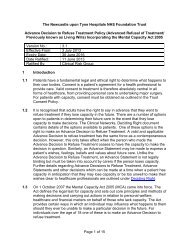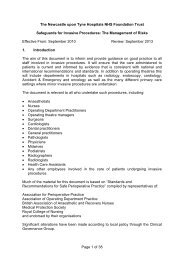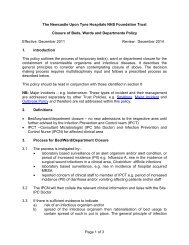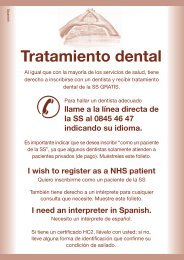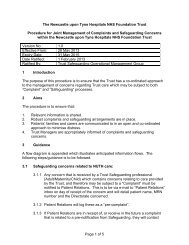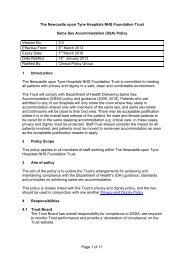Nursing Protocol for the Verification of Expected Death in the ...
Nursing Protocol for the Verification of Expected Death in the ...
Nursing Protocol for the Verification of Expected Death in the ...
You also want an ePaper? Increase the reach of your titles
YUMPU automatically turns print PDFs into web optimized ePapers that Google loves.
<strong>Nurs<strong>in</strong>g</strong> <strong>Protocol</strong> <strong>for</strong> <strong>the</strong> <strong>Verification</strong> <strong>of</strong> <strong>Expected</strong> <strong>Death</strong> <strong>in</strong> <strong>the</strong> Community<br />
1.0 Introduction<br />
The <strong>in</strong>tention <strong>of</strong> this policy is to support registered nurses <strong>in</strong> verify<strong>in</strong>g<br />
expected death <strong>in</strong> <strong>the</strong> community <strong>for</strong> those patients with a palliative<br />
diagnosis. Historically verification has been carried out by medical<br />
practitioners who are deputis<strong>in</strong>g <strong>for</strong> <strong>the</strong> patients General Practitioner. This<br />
practice occurs most frequently Out <strong>of</strong> Hours when <strong>the</strong> patients General<br />
Practitioners service is unavailable. In recent years <strong>the</strong>re has been an<br />
acknowledgement that a registered general nurse who has undertaken<br />
education can per<strong>for</strong>m this role. Certification <strong>of</strong> death is <strong>the</strong> legal<br />
responsibility <strong>of</strong> <strong>the</strong> patients General Practitioner.<br />
2.0 Purpose<br />
The purpose <strong>of</strong> this protocol is to provide a safe framework to enable<br />
qualified nurs<strong>in</strong>g staff to verify expected death <strong>in</strong> <strong>the</strong> community. It is also to<br />
reduce <strong>the</strong> delay between death occurr<strong>in</strong>g and verification tak<strong>in</strong>g place <strong>for</strong><br />
<strong>the</strong> benefit <strong>of</strong> relatives / carers.<br />
3.0 Legal Position<br />
The Law requires that:<br />
“A registered medical practitioner, who has attended a deceased<br />
person dur<strong>in</strong>g his last illness, is required to give a medical certificate <strong>of</strong><br />
<strong>the</strong> cause <strong>of</strong> death ‘to <strong>the</strong> best <strong>of</strong> his knowledge and belief’ and to<br />
deliver that certificate <strong>for</strong>thwith to <strong>the</strong> Registrar. The certificate<br />
requires that <strong>the</strong> doctor state <strong>the</strong> last date on which he saw <strong>the</strong><br />
deceased person alive, and whe<strong>the</strong>r or not he saw <strong>the</strong> body after<br />
death.”<br />
“He is not obliged to view <strong>the</strong> body, but good practice requires that if<br />
he has any doubt about <strong>the</strong> fact <strong>of</strong> death, he should satisfy himself <strong>in</strong><br />
this way.”<br />
Report <strong>of</strong> <strong>the</strong> Committee on <strong>the</strong> <strong>Death</strong> Certification and Coroners Home<br />
Office (1971).<br />
September 2012
The Law does not require:<br />
A doctor to verify death has occurred or that “life is ext<strong>in</strong>ct”<br />
A doctor to view <strong>the</strong> body <strong>of</strong> a deceased person<br />
A doctor to report <strong>the</strong> fact that a death has occurred<br />
Confirmation & Certification <strong>of</strong> <strong>Death</strong>: Guidance <strong>for</strong> GP’s <strong>in</strong> England & Wales<br />
(1999)<br />
4.0 Nurses who may work to this protocol<br />
Registered nurses, work<strong>in</strong>g to this protocol, have <strong>the</strong> authority to verify<br />
expected death, notify relatives and advise <strong>the</strong>m on <strong>the</strong> removal <strong>of</strong> <strong>the</strong> body<br />
to an undertaker <strong>of</strong> <strong>the</strong>ir choice. When <strong>in</strong>dicated <strong>the</strong> nurse is empowered to<br />
follow <strong>the</strong> procedure to notify <strong>the</strong> coroner.<br />
A registered nurse who has undertaken tra<strong>in</strong><strong>in</strong>g <strong>in</strong> verification <strong>of</strong> death and<br />
who feels confident to undertake this role with<strong>in</strong> <strong>the</strong> <strong>Nurs<strong>in</strong>g</strong> and Midwifery<br />
Council (N.M.C) (2009) Scope <strong>of</strong> Pr<strong>of</strong>essional Practice.<br />
5.0 Indications <strong>for</strong> Nurse <strong>Verification</strong><br />
The death must be expected, <strong>for</strong> <strong>the</strong> purposes <strong>of</strong> this protocol, expected<br />
death can be def<strong>in</strong>ed as:<br />
<strong>Death</strong> follow<strong>in</strong>g on from a period <strong>of</strong> illness, which has been identified<br />
as palliative.<br />
Where <strong>the</strong> nurs<strong>in</strong>g services have been <strong>in</strong>volved <strong>in</strong> provid<strong>in</strong>g palliative<br />
care, and <strong>the</strong>re has been no active <strong>in</strong>tervention to prolong life is<br />
ongo<strong>in</strong>g.<br />
6.0 Contra Indications to Nurse <strong>Verification</strong><br />
Nurses must not verify any <strong>of</strong> <strong>the</strong> follow<strong>in</strong>g deaths:<br />
The death <strong>of</strong> a child (0-18years).<br />
<strong>Death</strong>s <strong>of</strong> unidentified persons.<br />
<strong>Death</strong>s <strong>of</strong> people not under obvious medical and/or nurs<strong>in</strong>g care.<br />
<strong>Death</strong> which occurs with<strong>in</strong> 24 hours <strong>of</strong> onset <strong>of</strong> illness, or where no<br />
firm cl<strong>in</strong>ical diagnosis has been made.<br />
<strong>Death</strong>s directly follow<strong>in</strong>g post-operative or post <strong>in</strong>vasive procedures.<br />
<strong>Death</strong>s which follow an untoward <strong>in</strong>cident, fall or drug error.<br />
<strong>Death</strong>s which occur as a result <strong>of</strong> negligence or malpractice.<br />
Any unclear or remotely suspicious death.<br />
September 2012
September 2012<br />
In <strong>the</strong> case <strong>of</strong> a death which falls <strong>in</strong>to any <strong>of</strong> <strong>the</strong> categories above, <strong>the</strong><br />
nurse should not confirm <strong>the</strong> death, but refer to <strong>the</strong> Registered Medical<br />
Practitioner / on-call Locum or Police / Coroner.<br />
<strong>Death</strong>s <strong>of</strong> patients with<strong>in</strong> cont<strong>in</strong>u<strong>in</strong>g care nurs<strong>in</strong>g home beds<br />
7.0 Indications <strong>for</strong> <strong>in</strong><strong>for</strong>m<strong>in</strong>g <strong>the</strong> Coroner <strong>in</strong> an expected <strong>Death</strong><br />
There are certa<strong>in</strong> circumstances <strong>in</strong> which <strong>the</strong> Coroner must legally be<br />
<strong>in</strong><strong>for</strong>med <strong>of</strong> an expected death. The most common situation is when patients<br />
has a diagnosis <strong>of</strong> Meso<strong>the</strong>lioma. The coroner may be required to per<strong>for</strong>m<br />
a post mortem. It is not possible to <strong>in</strong>clude a complete list <strong>of</strong> all situations<br />
with<strong>in</strong> this protocol. It is <strong>the</strong> responsibility <strong>of</strong> <strong>the</strong> Multi-Discipl<strong>in</strong>ary team to<br />
identify and document <strong>the</strong> need <strong>for</strong> <strong>the</strong> coroner to be <strong>in</strong><strong>for</strong>med, with<strong>in</strong> <strong>the</strong><br />
patients’ records and where appropriate discuss with <strong>the</strong> patient, relatives<br />
and carers.<br />
8.0 Process <strong>of</strong> Nurse <strong>Verification</strong><br />
1. The nurse should check <strong>the</strong> patient’s nurs<strong>in</strong>g documentation to<br />
establish that <strong>the</strong> death is expected.<br />
The nurse should establish that <strong>the</strong>re are no contra <strong>in</strong>dications <strong>for</strong> <strong>the</strong><br />
verification <strong>of</strong> death.<br />
2. The nurse should establish cl<strong>in</strong>ical signs <strong>of</strong> death us<strong>in</strong>g <strong>the</strong> follow<strong>in</strong>g<br />
criteria:<br />
Absence <strong>of</strong> carotid pulse <strong>for</strong> 1 m<strong>in</strong>ute.<br />
Absence <strong>of</strong> heart sounds <strong>for</strong> 1 m<strong>in</strong>ute.<br />
Absence <strong>of</strong> respiratory movements and breath sounds <strong>for</strong> 1<br />
m<strong>in</strong>ute.<br />
Fixed and dilated pupils.<br />
3a. If <strong>the</strong> death is expected subcutaneous parenteral drug(s) to be<br />
discont<strong>in</strong>ued and discarded, as per Standard Operat<strong>in</strong>g Procedure<br />
(SOP) – The Disposal <strong>of</strong> unwanted Controlled Drugs from Patient<br />
Homes by Community Nurses NNTCHCLINSOP002:<br />
http://nww.nntch.nhs.uk/uploadedFiles/NNTCH_Library/Documents/<br />
NNTCH%20CLINSOP002%20Disposal%20<strong>of</strong>%20Unwanted%20M<br />
edic<strong>in</strong>es%20By%20Community%20Nurses.pdf<br />
3b. If <strong>the</strong> death is suspicious do not discont<strong>in</strong>ue <strong>the</strong> syr<strong>in</strong>ge driver and<br />
ensure <strong>the</strong> environment is not disturbed. The police will attend.<br />
4 The nurse to confirm/<strong>in</strong><strong>for</strong>m <strong>the</strong> patient’s death with relatives/carers<br />
and advise on removal <strong>of</strong> <strong>the</strong> body to an undertaker <strong>of</strong> <strong>the</strong>ir choice or<br />
<strong>the</strong> coroner needs to be <strong>in</strong>volved and <strong>the</strong>re<strong>for</strong>e <strong>the</strong> coroner’s
September 2012<br />
deputy/police will attend and <strong>the</strong> body will be removed to <strong>the</strong> Royal<br />
Victoria Infirmary (RVI) mortuary.<br />
5 Nurse to <strong>in</strong><strong>for</strong>m relatives/carers regard<strong>in</strong>g obta<strong>in</strong><strong>in</strong>g death certificate.<br />
The relatives/carers should be advised to contact <strong>the</strong> patient’s General<br />
Practitioner on <strong>the</strong> next work<strong>in</strong>g day.<br />
6. Nurse to provide <strong>in</strong><strong>for</strong>mation to <strong>the</strong> relatives/carers regard<strong>in</strong>g D.W.P.<br />
(Department <strong>for</strong> Works and Pensions) booklet D49 “What to do after a<br />
death <strong>in</strong> England and Wales”. Best practice is <strong>for</strong> <strong>the</strong> nurse to provide<br />
<strong>the</strong> booklet.<br />
7. Nurse should assess <strong>the</strong> communication needs <strong>of</strong> <strong>the</strong> patient’s<br />
relatives/carers and identify any communication support required <strong>for</strong><br />
example language <strong>in</strong>terpreters or British sigh language <strong>in</strong>terpreters. The<br />
nurse should where possible access or signpost <strong>the</strong> relatives to <strong>the</strong><br />
appropriate communication support.<br />
9.0 Corneal or S<strong>of</strong>t Tissue Donation<br />
1. Nurse to review nurs<strong>in</strong>g documentation to establish if <strong>the</strong> deceased had<br />
an expressed wish to make a corneal or s<strong>of</strong>t tissue donation.<br />
2. Nurse to discuss with family that deceased had expressed a wish to<br />
make a corneal or s<strong>of</strong>t tissue donation and ga<strong>in</strong> permission to contact <strong>the</strong><br />
Tissue Service Co-ord<strong>in</strong>ator on 24 hour pager 07659180773.<br />
3. The Tissue Service Co-ord<strong>in</strong>ator will discuss donation and <strong>for</strong>mal<br />
consent from <strong>the</strong> family via <strong>the</strong> telephone.<br />
4. In cases where <strong>the</strong> coroner needs to be <strong>in</strong>volved <strong>the</strong> Tissue Service Coord<strong>in</strong>ator<br />
will liaise with <strong>the</strong> Coroner.<br />
10.0 Documentation<br />
If a patients care is be<strong>in</strong>g documented us<strong>in</strong>g <strong>the</strong> Liverpool Integrated<br />
Care Pathway <strong>for</strong> <strong>the</strong> Dy<strong>in</strong>g Patient (LCP/ICP):<br />
Complete LCP/ICP Document Section 3<br />
Complete one copy <strong>of</strong> “<strong>Verification</strong> <strong>of</strong> <strong>Expected</strong> <strong>Death</strong> by Registered<br />
Nurses” <strong>for</strong>m which is <strong>in</strong>cluded with<strong>in</strong> <strong>the</strong> LCP/ICP.<br />
This <strong>for</strong>m should be removed from <strong>the</strong> records, to enable it to be faxed<br />
with<strong>in</strong> 24 hours to patient’s General Practitioner and <strong>the</strong> orig<strong>in</strong>al copy<br />
posted.<br />
The General Practitioner and named community nurse should be<br />
notified <strong>of</strong> patient’s death on <strong>the</strong> next work<strong>in</strong>g day.
Nurse to document <strong>Verification</strong> <strong>of</strong> <strong>Death</strong> on Systm One.<br />
If patient care is not be<strong>in</strong>g documented us<strong>in</strong>g <strong>the</strong> LCP/ICP:<br />
Complete two copies <strong>of</strong> “<strong>Verification</strong> <strong>of</strong> <strong>Expected</strong> <strong>Death</strong> by Registered<br />
Nurses” <strong>for</strong>m.<br />
Leave one copy <strong>of</strong> <strong>the</strong> document <strong>in</strong> patient’s nurs<strong>in</strong>g notes.<br />
The second <strong>for</strong>m should be faxed with<strong>in</strong> 24 hours to patient’s General<br />
Practitioner and <strong>the</strong> orig<strong>in</strong>al copy posted.<br />
The General Practitioner and named community nurse should be<br />
notified <strong>of</strong> patient’s death on <strong>the</strong> next work<strong>in</strong>g day.<br />
Nurse to document <strong>Verification</strong> <strong>of</strong> <strong>Death</strong> on Systm One.<br />
11.0 <strong>Verification</strong> <strong>of</strong> expected death when <strong>the</strong> coroner needs to be <strong>in</strong><strong>for</strong>med.<br />
In Hours: Monday to Friday, 8.00 am – 4.00 pm<br />
The Registered Nurse who has verified <strong>the</strong> patient’s death should liaise with<br />
<strong>the</strong> General Practitioner who will usually take responsibility <strong>for</strong> contact<strong>in</strong>g<br />
<strong>the</strong> Coroners Office.<br />
Newcastle<br />
The Coroners Office<br />
Civic Centre<br />
Barras Bridge<br />
Newcastle upon Tyne<br />
NE1 8PS<br />
Tel: 0191 277 7280<br />
North Tyneside<br />
The Coroners Office<br />
Wallsend Police Station<br />
Middle Eng<strong>in</strong>e Lane<br />
Wallsend<br />
North Tyneside<br />
NE28 9NT<br />
Tel: 03456 043 043<br />
Ext: 45154<br />
Out <strong>of</strong> Hours: Saturday/Sunday/Bank Holidays or Monday-Friday, 4.00pm<br />
8.00 am<br />
The Registered Nurse who has verified <strong>the</strong> patient’s death should contact<br />
<strong>the</strong> coroner’s deputy who are Northumbria Police by telephone on Tel:<br />
03456 043 043<br />
The Police will attend.<br />
The Police Officer will confirm with relatives <strong>the</strong> identity <strong>in</strong>clud<strong>in</strong>g<br />
attach<strong>in</strong>g an identification bracelet.<br />
The police will arrange removal <strong>of</strong> <strong>the</strong> body to <strong>the</strong> RVI mortuary.<br />
September 2012
References<br />
The follow<strong>in</strong>g work<strong>in</strong>g day <strong>the</strong> Coroner will contact <strong>the</strong> General<br />
Practitioner.<br />
The Coroners Department will contact <strong>the</strong> family with an appo<strong>in</strong>tment<br />
<strong>for</strong> <strong>the</strong> next day.<br />
Confirmation & Certification <strong>of</strong> <strong>Death</strong>: Guidance <strong>for</strong> GP’s <strong>in</strong> England & Wales<br />
(1999)<br />
Embrac<strong>in</strong>g Diversity <strong>in</strong> Mental Heath Care: A resource on a Major Faiths <strong>in</strong> <strong>the</strong> UK<br />
<strong>Nurs<strong>in</strong>g</strong> and Midwifery Council (N.M.C.) Code <strong>of</strong> Conduct (2009).<br />
Report <strong>of</strong> <strong>the</strong> Committee on <strong>the</strong> <strong>Death</strong> Certification and Coroners Home Office<br />
(1971).<br />
September 2012
<strong>Verification</strong> <strong>of</strong> <strong>Expected</strong> <strong>Death</strong> by Registered Nurses<br />
GP / Consultant:<br />
Patient Name:<br />
……………………………………………..<br />
Address: ………………………………….<br />
……………………………………………..<br />
Date <strong>of</strong> Birth: ……………………………..<br />
Named Nurse:<br />
Next <strong>of</strong> K<strong>in</strong>’s Name (pr<strong>in</strong>t):<br />
…………………………………………………<br />
Address: ...……………………………………<br />
…………………………………………………<br />
…………………………………………………<br />
NHS No: ………………………………….<br />
Diagnosis: ………………………………..<br />
Telephone: ……………………………………<br />
Name(s) <strong>of</strong> those present at <strong>the</strong> time <strong>of</strong> death and relationship to patient (pr<strong>in</strong>t):<br />
…………………………………………………………………………………………………………<br />
Cl<strong>in</strong>ical Record<strong>in</strong>gs (please tick)<br />
Pupil reaction absent (both pupils fixed and dilated, not react<strong>in</strong>g to light)<br />
Femoral or Carotid Pulse absent (no pulse <strong>for</strong> 1 m<strong>in</strong>ute)<br />
Respirations absent (no breath sounds <strong>for</strong> 1 m<strong>in</strong>ute)<br />
Heart sounds absent (no heart sounds <strong>for</strong> 1 m<strong>in</strong>ute)<br />
Time and date <strong>of</strong> death: ……………………………………………………………………………<br />
Time and date <strong>of</strong> verification: ……………………………………………………………………..<br />
Name <strong>of</strong> Nurse (please pr<strong>in</strong>t): ………………………………….. Signature: …………………..<br />
Subcutaneous Parenteral Drug(s) discont<strong>in</strong>ued and discarded, as per Trust / Organisation<br />
<strong>Protocol</strong><br />
<br />
Name, address & telephone number <strong>of</strong> Funeral Director (if known)<br />
…………………………………………………………………………………………………………<br />
Formal communication to patient’s GP with<strong>in</strong> 24 hours (please complete)<br />
Faxed Date & Time: ………………………<br />
Telephoned Date & Time: ……………………..<br />
O<strong>the</strong>r (please specify): ……………………………….. Date & Time: ………………………….<br />
September 2012
NEWCASTLE AND NORTH TYNESIDE COMMUNITY HEALTH<br />
VERIFICATION OF EXPECTED DEATH BY A REGISTERED NURSE<br />
IN A COMMUNITY SETTING<br />
Patient dies<br />
<strong>Death</strong> expected<br />
No<br />
Do not discont<strong>in</strong>ue syr<strong>in</strong>ge driver<br />
Do not disturb <strong>the</strong> environment<br />
Yes<br />
Nurse verifies death as per protocol<br />
Contact GP and / or Police if<br />
appropriate<br />
Nurse establishes if deceased expressed<br />
wish to donate tissues / organs<br />
No<br />
Yes<br />
Family agree to nurse contact<strong>in</strong>g<br />
Tissue Service Co-ord<strong>in</strong>ator<br />
Tel: 07659180773<br />
Nurse <strong>in</strong><strong>for</strong>ms relatives<br />
Does coroner need to be <strong>in</strong><strong>for</strong>med<br />
Yes<br />
No<br />
Is it with<strong>in</strong> work<strong>in</strong>g hours<br />
Is it with<strong>in</strong> work<strong>in</strong>g hours<br />
Yes<br />
No<br />
Yes<br />
No<br />
Contact GP who<br />
will <strong>in</strong><strong>for</strong>m<br />
coroner<br />
Contact coroner’s<br />
deputy (Police) as<br />
per protocol<br />
Tel: 03456 043 043<br />
Contact GP who may wish<br />
to view body <strong>in</strong> <strong>the</strong> home<br />
prior to certification<br />
Coroner’s Deputy (Police) will attend and<br />
advise re: removal <strong>of</strong> body<br />
Advise relative / carer to contact undertaker<br />
to arrange <strong>for</strong> removal <strong>of</strong> body<br />
Ensure documentation is complete as per protocol.<br />
Ensure GP has been <strong>in</strong><strong>for</strong>med <strong>of</strong> death by fax, and by send<strong>in</strong>g hard copy by post.<br />
If out <strong>of</strong> hours, <strong>in</strong><strong>for</strong>m GP by telephone at start <strong>of</strong> next work<strong>in</strong>g day.<br />
ALWAYS REFER TO PROTOCOL Jan 2011<br />
September 2012
THE NEWCASTLE UPON TYNE HOSPITALS NHS FOUNDATION TRUST<br />
IMPACT ASSESSMENT – SCREENING FORM A<br />
This <strong>for</strong>m must be completed and attached to any procedural document when submitted to <strong>the</strong> appropriate committee <strong>for</strong> consideration and approval.<br />
Policy Title: <strong>Verification</strong> <strong>of</strong> <strong>Expected</strong> <strong>Death</strong> by Community Nurses Policy Author:<br />
Yes/No<br />
1. Does <strong>the</strong> policy/guidance affect one group less or more favourably than ano<strong>the</strong>r on<br />
<strong>the</strong> basis <strong>of</strong> <strong>the</strong> follow<strong>in</strong>g: (* denotes protected characteristics under <strong>the</strong> Equality<br />
Act 2010)<br />
• Race * No<br />
• Ethnic orig<strong>in</strong>s (<strong>in</strong>clud<strong>in</strong>g gypsies and travellers) No<br />
• Nationality No<br />
• Gender * No<br />
• Culture No<br />
• Religion or belief * No<br />
• Sexual orientation <strong>in</strong>clud<strong>in</strong>g lesbian, gay and bisexual people * No<br />
• Age * No<br />
• Disability – learn<strong>in</strong>g difficulties, physical disability, sensory impairment and<br />
mental health problems *<br />
No<br />
• Gender reassignment * No<br />
• Marriage and civil partnership * No<br />
2. Is <strong>the</strong>re any evidence that some groups are affected differently No<br />
3. If you have identified potential discrim<strong>in</strong>ation which can <strong>in</strong>clude associative<br />
discrim<strong>in</strong>ation i.e. direct discrim<strong>in</strong>ation aga<strong>in</strong>st someone because <strong>the</strong>y associate<br />
with ano<strong>the</strong>r person who possesses a protected characteristic, are any exceptions<br />
No<br />
valid, legal and/or justifiable<br />
4(a).<br />
Is <strong>the</strong> impact <strong>of</strong> <strong>the</strong> policy/guidance likely to be negative<br />
(If “yes”, please answer sections 4(b) to 4(d)).<br />
N/A<br />
4(b). If so can <strong>the</strong> impact be avoided N/A<br />
4(c). What alternatives are <strong>the</strong>re to achiev<strong>in</strong>g <strong>the</strong> policy/guidance without <strong>the</strong> impact N/A<br />
4(d) Can we reduce <strong>the</strong> impact by tak<strong>in</strong>g different action N/A<br />
Sally Adam-Lead Nurse End <strong>of</strong> Life/Bereavement, Lesley<br />
Robson-Palliative Care CNS<br />
You must provide evidence to support your response:<br />
No This Policy is procedural and as such applies equally to all ,<br />
it requires <strong>for</strong>ethought and proactive plann<strong>in</strong>g which will<br />
require an holistic assessment that will consider <strong>in</strong>dividuals<br />
needs<br />
Comments:<br />
Action Plan due (or Not Applicable):<br />
Name and Designation <strong>of</strong> Person responsible <strong>for</strong> completion <strong>of</strong> this <strong>for</strong>m: Sally Adam Lead Nurse End <strong>of</strong> Life/Bereavement. Date: 11 September 2012<br />
Names & Designations <strong>of</strong> those <strong>in</strong>volved <strong>in</strong> <strong>the</strong> impact assessment screen<strong>in</strong>g process: Sally Adam<br />
(If any reader <strong>of</strong> this procedural document identifies a potential discrim<strong>in</strong>atory impact that has not been identified on this <strong>for</strong>m, please refer to <strong>the</strong> Policy Author identified above, toge<strong>the</strong>r<br />
with any suggestions <strong>for</strong> <strong>the</strong> actions required to avoid/reduce this impact.)<br />
For advice on answer<strong>in</strong>g <strong>the</strong> above questions please contact Frances Blackburn, Head <strong>of</strong> <strong>Nurs<strong>in</strong>g</strong>, Freeman/Walkergate, or, Christ<strong>in</strong>e Holland, Senior HR Manager. On completion this <strong>for</strong>m must be <strong>for</strong>warded<br />
electronically to Steven Stoker, Cl<strong>in</strong>ical Effectiveness Manager, (Ext. 24963) steven.stoker@nuth.nhs.uk toge<strong>the</strong>r with <strong>the</strong> procedural document. If you have identified a potential discrim<strong>in</strong>atory impact <strong>of</strong> this<br />
procedural document, please ensure that you arrange <strong>for</strong> a full consultation, with relevant stakeholders, to complete a Full Impact Assessment (Form B) and to develop an Action Plan to avoid/reduce this<br />
impact; both Form B and <strong>the</strong> Action Plan should also be sent electronically to Steven Stoker with<strong>in</strong> six weeks <strong>of</strong> <strong>the</strong> completion <strong>of</strong> this <strong>for</strong>m.<br />
IMPACT ASSESSMENT FORM A October 2010


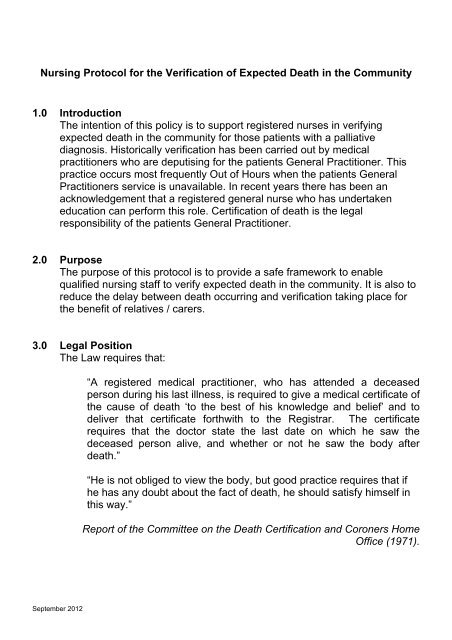
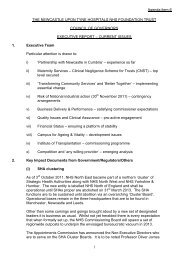
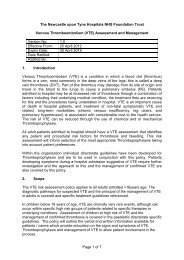
![Standard Precautions Policy - 112KB [PDF] - Newcastle Hospitals](https://img.yumpu.com/51150129/1/184x260/standard-precautions-policy-112kb-pdf-newcastle-hospitals.jpg?quality=85)
![Oxygen Management Policy - 38KB [PDF] - Newcastle Hospitals](https://img.yumpu.com/50798872/1/184x260/oxygen-management-policy-38kb-pdf-newcastle-hospitals.jpg?quality=85)
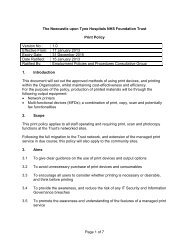
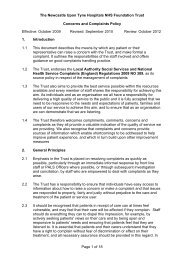
![Patient Identification Policy - 130KB [PDF] - Newcastle Hospitals](https://img.yumpu.com/49156101/1/190x245/patient-identification-policy-130kb-pdf-newcastle-hospitals.jpg?quality=85)
